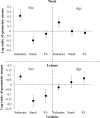A comparison of standard and compositional data analysis in studies addressing group differences in sedentary behavior and physical activity
- PMID: 29903009
- PMCID: PMC6003121
- DOI: 10.1186/s12966-018-0685-1
A comparison of standard and compositional data analysis in studies addressing group differences in sedentary behavior and physical activity
Abstract
Background: Data on time spent in physical activity, sedentary behavior and sleep during a day is compositional in nature, i.e. they add up to a constant value. Compositional data have fundamentally different properties from unconstrained data in real space, and require other analytical procedures, referred to as compositional data analysis (CoDA). Most physical activity and sedentary behavior studies, however, still apply analytical procedures adapted to data in real space, which can lead to misleading results. The present study describes a comparison of time spent sedentary and in physical activity between age groups and sexes, and investigates the extent to which results obtained by CoDA differ from those obtained using standard analytical procedures.
Methods: Time spent sedentary, standing, and in physical activity (walking/running/stair climbing/cycling) during work and leisure was determined for 1-4 days among 677 blue-collar workers using accelerometry. Differences between sexes and age groups were tested using MANOVA, using both a standard and a CoDA approach based on isometric log-ratio transformed data.
Results: When determining differences between sexes for different activities time at work, the effect size using standard analysis (η2 = 0.045, p < 0.001) was 15% smaller than that obtained with CoDA (η2 = 0.052, p < 0.001), although both approaches suggested a statistically significant difference. When determining corresponding differences between age groups, CoDA resulted in a 60% larger, and significant, effect size (η2 = 0.012, p = 0.02) than that obtained with the standard approach (η2 = 0.008, p = 0.07). During leisure, results based on standard (age; η2 = 0.007, p = 0.09; sex; η2 = 0.052, p < 0.001) and CoDA (age; η2 = 0.007, p = 0.09; sex; η2 = 0.051, p < 0.001) analyses were similar.
Conclusion: Results and, hence, inferences concerning age and sex-based differences in time spent sedentary and in physical activity at work differed between CoDA and standard analysis. We encourage researchers to use CoDA in similar studies, to adequately account for the compositional nature of data on physical activity and sedentary behavior.
Keywords: Accelerometry; Age; CoDA; CoDA-based MANOVA; Isometric log-ratio; Sex.
Conflict of interest statement
Ethics approval and consent to participate
All workers provided their written informed consent prior to participation. The DPHACTO study was conducted according to the Helsinki declaration and approved by the regional Ethics Committee (The Capital Region of Denmark, H-2-2012-011).
Competing interests
The authors declare that they have no competing interests.
Publisher’s Note
Springer Nature remains neutral with regard to jurisdictional claims in published maps and institutional affiliations.
Figures



Similar articles
-
24-h movement behaviors from infancy to preschool: cross-sectional and longitudinal relationships with body composition and bone health.Int J Behav Nutr Phys Act. 2018 Nov 26;15(1):118. doi: 10.1186/s12966-018-0753-6. Int J Behav Nutr Phys Act. 2018. PMID: 30477518 Free PMC article.
-
Daily domain-specific time-use composition of physical behaviors and blood pressure.Int J Behav Nutr Phys Act. 2019 Jan 10;16(1):4. doi: 10.1186/s12966-018-0766-1. Int J Behav Nutr Phys Act. 2019. PMID: 30630517 Free PMC article.
-
What Is the Effect on Obesity Indicators from Replacing Prolonged Sedentary Time with Brief Sedentary Bouts, Standing and Different Types of Physical Activity during Working Days? A Cross-Sectional Accelerometer-Based Study among Blue-Collar Workers.PLoS One. 2016 May 17;11(5):e0154935. doi: 10.1371/journal.pone.0154935. eCollection 2016. PLoS One. 2016. PMID: 27187777 Free PMC article.
-
Analysis of the 24-h activity cycle: An illustration examining the association with cognitive function in the Adult Changes in Thought study.Front Psychol. 2023 Mar 27;14:1083344. doi: 10.3389/fpsyg.2023.1083344. eCollection 2023. Front Psychol. 2023. PMID: 37057157 Free PMC article. Review.
-
A systematic review of research reporting practices in observational studies examining associations between 24-h movement behaviors and indicators of health using compositional data analysis.J Act Sedentary Sleep Behav. 2024;3(1):23. doi: 10.1186/s44167-024-00062-8. Epub 2024 Oct 2. J Act Sedentary Sleep Behav. 2024. PMID: 39371105 Free PMC article. Review.
Cited by
-
Effects of Two Randomized and Controlled Multi-Component Interventions Focusing On 24-Hour Movement Behavior among Office Workers: A Compositional Data Analysis.Int J Environ Res Public Health. 2021 Apr 15;18(8):4191. doi: 10.3390/ijerph18084191. Int J Environ Res Public Health. 2021. PMID: 33920971 Free PMC article. Clinical Trial.
-
Daily time-use compositions of physical behaviours and its association with evaluative and experienced wellbeing: a multilevel compositional analysis.Int J Behav Nutr Phys Act. 2025 Jun 11;22(1):73. doi: 10.1186/s12966-025-01769-w. Int J Behav Nutr Phys Act. 2025. PMID: 40500771 Free PMC article.
-
Psychophysiological Reactivity, Postures and Movements among Academic Staff: A Comparison between Teleworking Days and Office Days.Int J Environ Res Public Health. 2021 Sep 10;18(18):9537. doi: 10.3390/ijerph18189537. Int J Environ Res Public Health. 2021. PMID: 34574461 Free PMC article.
-
Secondary prevention by striking the balance in 24-hour movement behaviour by empowering people at risk with a stroke: rationale and design of the RISE intervention randomised controlled trial.BMJ Open. 2025 Jun 5;15(6):e094894. doi: 10.1136/bmjopen-2024-094894. BMJ Open. 2025. PMID: 40473286 Free PMC article.
-
Sedentary Time and Metabolic Risk in Extremely Active Older Adults.Diabetes Care. 2021 Jan;44(1):194-200. doi: 10.2337/dc20-0849. Epub 2020 Oct 16. Diabetes Care. 2021. PMID: 33067259 Free PMC article.
References
-
- Young DR, Hivert MF, Alhassan S, Camhi SM, Ferguson JF, Katzmarzyk PT, Lewis CE, Owen N, Perry CK, Siddique J, et al. Sedentary behavior and cardiovascular morbidity and mortality: a science advisory from the American Heart Association. Circulation. 2016;134:e262–e279. doi: 10.1161/CIR.0000000000000440. - DOI - PubMed
Publication types
MeSH terms
Grants and funding
LinkOut - more resources
Full Text Sources
Other Literature Sources
Medical

